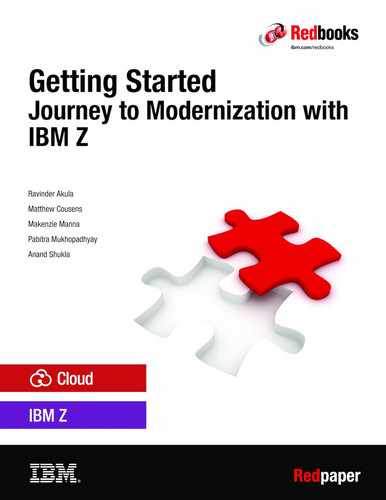Modernization of enterprise IT applications and infrastructure is key to the survival of organizations. It is no longer a matter of choice. The cost of missing out on business opportunities in an intensely competitive market can be enormous. To aid in their success, organizations are facing increased encouragement to embrace change. They are pushed to think of new and innovative ways to counter, or offer, a response to threats that are posed by competitors who are equally as aggressive in adopting newer methods and technologies. The term modernization often varies in meaning based on perspective. This IBM® Redbooks® publication focuses on the technological advancements that unlock computing environments that are hosted on IBM Z® to enable secure processing at the core of hybrid. This publication is intended for IT executives, IT managers, IT architects, System Programmers, and Application Developer professionals.
Table of Contents
- Front cover
- Notices
- Preface
- Chapter 1. Introduction to modernization
- 1.1 What is IBM Z?
- 1.2 Why IBM Z?
- 1.2.1 Shift in computing paradigm
- 1.3 What is modernization?
- 1.4 What drives modernization?
- 1.4.1 Business agility and speed-to-market
- 1.4.2 Integration and interoperability of enterprise systems
- 1.4.3 Security, trust, compliance, and regulatory requirements
- 1.4.4 Resource optimization
- 1.4.5 Managing enormous amount of data
- 1.5 How does modernization relate to IBM Z?
- 1.5.1 Containerization and hybrid multi-cloud
- 1.5.2 Securing data on IBM Z
- 1.5.3 Higher availability, resiliency, and performance demands
- 1.5.4 Skill development, lower learning curve, and productivity benefits
- 1.5.5 Vendor lock-in
- 1.5.6 Open-source software adoption and integration
- 1.5.7 Mindset change
- 1.6 Modernization journey
- 1.6.1 Phase 1: Learn
- 1.6.2 Phase 2: Adopt
- 1.6.3 Phase 3: Deploy
- Chapter 2. Modernization goals and approaches
- Chapter 3. Modernization technologies on IBM Z
- Chapter 4. Introduction to DevOps
- 4.1 DevOps culture
- 4.2 DevOps on IBM Z
- 4.2.1 Continuous delivery and deployment with IBM Z
- 4.3 Analyze and plan
- 4.4 Source code managers
- 4.5 Code
- 4.5.1 Cloud-native
- 4.5.2 Integrated development environments
- 4.6 Build
- 4.7 Test
- 4.8 Provision, deploy, and release
- 4.8.1 Continuous delivery with Jenkins and UrbanCode Deploy
- Chapter 5. Modernization best practices
- 5.1 Using a Source Code Manager
- 5.2 Deploying common tools across platforms
- 5.3 Embracing new methods and means
- 5.4 Allowing self-provisioned testing
- 5.5 Consider emulated environments for early testing
- 5.6 Updating older COBOL applications
- 5.7 Performing regular assessments of new features and functions
- 5.8 Watching for latency
- 5.9 Making your talent future-proof
- 5.10 Getting help from experts
- Chapter 6. Putting it all together
- 6.1 What is a technical showcase?
- 6.2 Topology overview
- 6.2.1 Showcase technologies
- 6.3 ISTPOMA: Stock trader application
- 6.4 Jenkins
- 6.5 Ansible
- 6.6 z/OS Management Facility
- 6.6.1 Cloud Provisioning and Management overview
- 6.6.2 Workflows overview
- 6.6.3 Provisioning middleware with CP&M
- 6.7 Zowe
- 6.7.1 Zowe CLI overview
- 6.7.2 Zowe CLI in a Docker container
- 6.8 Db2
- 6.8.1 Db2 as our database
- 6.9 Customer Information Control System
- 6.9.1 CICS as transactional manager
- 6.10 z/OS Connect
- 6.10.1 Interacting with COBOL application
- 6.11 IBM MQ
- 6.11.1 IBM MQ as messaging queue
- 6.12 Summary
- Related publications
- Back cover
